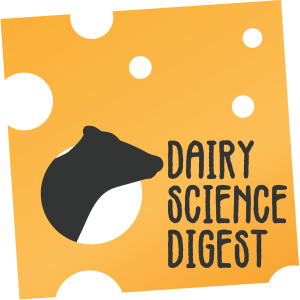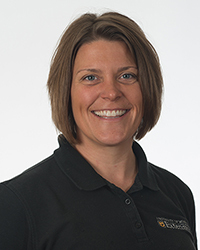Dairy Science Digest
Dairy Science Digest - a podcast developed to share the MOST current research published in the Journal of Dairy science. Hear directly from the research authors on how their results can impact your herd’s profitability. Science you can base your management decisions around. Designed to rarely exceed 30 minutes, this podcast provides ONLY the ”need to know” info for dairy producers. Keywords: dairy, science, reproduction, production, extension, cattle, MIZZOU, MU, Dairy Team, #2xAg2030
Episodes

Sunday Oct 15, 2023
DSD 4.10 | Prevent Early Embryonic Losses
Sunday Oct 15, 2023
Sunday Oct 15, 2023
Pregnancy is the key to profitability, ensuring your herd remains in the most profitable phase of production. However, these early embryos are delicate and often are not carried out through the entire 283 days of gestation. This month we talk with Dr. Stephen LaBlanc, from the University of Guelph about quantifying the frequency of early pregnancy loss in healthy animal and his team’s quest to determine the impact of a failed transition on the cow’s ability to carry the pregnancy to term.
Through management, a producer can prevent the spiral of negative events that result in increased odds of pregnancy loss. The research team determined day 19 pregnancy and tracked the success, or failure, through day 63. Listen in to hear what different parameters they found to have an increased probability of early pregnancy loss.
These findings were published in the Journal of Dairy Science article titled, “The associations of inflammatory and reproductive tract disorders postpartum and early pregnancy loss in dairy cows” This open access article, is available for download to view while you listen in!
Topics of discussion
1:32 Introduction of Dr. LaBlanc 2:15 Description of Research Herds 3:34 On farm monitoring – data collected 5:55 Uterine sampling7:32 Uterine cytology at 5 weeks postpartum8:53 Blood progesterone9:53 Common cycling rate in early lactation10:52 Day 19 pregnancy analysis 14:03 Figure 1: Predicted probably of pregnancy – Healthy vs diseased transition15:19 Conception frequency 16:14 Day 19 – 40 pregnancy loss 17:30 Metritis hangover 18:34 Figure 2: Predicted probably of pregnancy – number of clinical disease20:00 Single disease vs multiple clinical diseases impact on pregnancy loss22:31 Driving force to what predicts pregnancy loss in a dairy herd24:13 One in Five cows 24:49 One two punch of failure 25:05 Inflammation effect on the ovary 27:53 What do you want dairy producers to know from your research #2xAg2030; #journalofdairyscience; @jdairyscience; #openaccess; #MODAIRY; #earlyembryonicloss; #pregloss, #Ploss; #transition; #transitiondairy; #dairysciencedigest; #ReaganBluel
https://www.journalofdairyscience.org/article/S0022-0302(23)00726-9/fulltext

Monday Sep 18, 2023
DSD 4.9 | Is your starch locked up by Zein proteins?
Monday Sep 18, 2023
Monday Sep 18, 2023
Corn silage is such piece in your ration. Much work has been done by corn breeders to create the most ideal plant with high yields, digestible forage AND starch to support lactation. This month we talk with Dr. José Varela and feature a foundational silage project he and his team worked on at the University of Wisconsin to better understand specifically how zein proteins around corn starch particles change overtime when fermented.
Corn breeders throughout the Land Grant University system collaborate and work hard to ensure the next line of genetically superior forage will perform on your operation - but genetics can only go so far. Silage inventory management ensures that the perfect alignment of fully fermented feed for your herd.
This project studied the differences in nutrient availability between 0, 1, 2, 4 & 8 months of fermentation. Listen in to best understand the risks of feeding green chop.
This timely topic is released while many dairies are in the field, or having just finished up with harvest. Take a listen in to best understand the value gained towards improving starch availability for your herd.
These findings were published in the Journal of Dairy Science featured article titled, “Effect of Endosperm Type and Storage Length of Whole Plant Corn Silage on Nitrogen Fraction, Fermentation Products, Zein Profile and Starch Digestibility” Open access, available for download.
Topics of discussion
1:51 Introduction of Dr. Varela4:00 Kernel Research – Starch matrix4:54 Description of the corn anatomy 5:30 Three major structures of the kernel 7:11 Vitreousness of the corn kernel 7:45 Role of land grants in research 8:41 Improving the kernel endosperm could also have agronomic flaws 9:58 The process of plot research – self vs cross fertilization to study kernel change 12:19 Chopping silage 12:33 Fermentation over time13:17 How did the silage change over time14:08 Results15:28 α-zeins break down during fermentation16:03 Figure 2 16:30 Feeding Green Chop18:42 Drought and high temperatures 21:05 Silage analysis 22:17 Invitro starch digestibility: vitreousness or α-zeins? 23:53 What would you like boots on the ground to know about your research project?25:17 Forage inventory – make a plan26:26 Inoculate with protease?
#2xAg2030; #journalofdairyscience; @jdairyscience; #openaccess; #MODAIRY; #protease; #landgrantresearch; #cornsilage, #starch; #milkyieldperacre; #agronomics, #dairysciencedigest; #ReaganBluel
https://www.journalofdairyscience.org/article/S0022-0302(23)00558-1/pdf

Tuesday Aug 15, 2023
DSD 4.8 | How does grass-based milk impact human nutrition?
Tuesday Aug 15, 2023
Tuesday Aug 15, 2023
Research in Ireland is focused around better understanding the intersection of management and cattle nutrition on the quality of the milk produced within a system. This month we talk specifically about three different feeding strategies – TMR, PMR or grass based investigated for an entire lactation.
The vast majority of Irish dairymen attempt to maximize use of grass as the primary feed source for their nation’s dairy herd. Therefore food scientists Dr. André Brodkorb and Mark Timlin and team at Teagasc in Ireland set out to capture quantifiable differences in the milk between systems.
Listen in this month to learn more about the changes in milk quality that could have marketing implications. In addition to shifts in fatty acid profile they also captured milk processing parameter changes. We discuss the possible role that might have on preparing milk for their export markets.
These findings were published in the Journal of Dairy Science featured article titled, Impact of varying levels of pasture allowance on the nutritional quality and functionality of milk throughout lactation” Open access, available for download.
Topics of discussion
2:23 Introduction of researchers7:11 Describe the Research Herd8:27 Fatty Acid Analysis11:00 Biologically relevant CLAs11:26 Description of 2 types of trans-fatty acids11:58 CLA concentration differences12:25 Omega 3 Fatty Acid concentrations12:44 Increase of ‘good fats’13:39 Decreased total fat production15:16 Somatic Cell count differences – Figure 117:38 Figure 3 – separate feeding systems visually by FA17:56 Figure 4 – visual heat map distinguishing dietary trt18:42 Biomarkers to determine the difference between grass and TMR 21:36 Expect a production volume decrease22:43 Grass fed dairy standards24:21 Pilot scale test products for human intervention trial27:49 Changes in milk and the impact on processing 30:52 UHT pasteurization and impact on nutrition, AA & FA 34:32 What would you like boots on the ground to know about your research project. #2xAg2030; #journalofdairyscience; @jdairyscience; #openaccess; #MODAIRY; #grassbasedmilk; #CLA, #grazing; #seasonaldairy; #fattyacid, #dairysciencedigest; #ReaganBluel
https://www.journalofdairyscience.org/article/S0022-0302(23)00433-2/fulltext

Saturday Jul 15, 2023
DSD 4.7 | Ketosis and Antioxidant ability - Chicken or the egg?
Saturday Jul 15, 2023
Saturday Jul 15, 2023
DSD 4.7 | Is there a relationship between Ketosis and antioxidant ability
For years, dairy producers have worked towards best understanding all the challenges a cow experiences as she transitions from dry into lactation. If we can best identify the animals who take this transition in stride, we can work towards improving the single most challenging part of dairy production. This month, we are joined by two Belgium researchers looking to examine the relationship between antioxidant activity and ketotis, specifically BHBA.
Dr. Fievez, ruminant nutritionist at Ghent University - in Belgium, worked with PhD candidate MQ Zhang to study the metabolic and antioxidant parameters of 110 animals through transition. Listen in to hear what you can learn about the complex transition dairy cow!
These findings were published in the Journal of Dairy Science article titled, “Transition cow clusters with distinctive antioxidant ability and their relation to performance and metabolic status in early lactation.” Open access, available for download.
Topics of discussion
3:17 Importance of determining Antioxidative Ability 4:44 Hypothesis – structure of the project 5:16 Metabolic parameters studied and their relationship to oxidation5:31 Background of BHBA 6:02 Negative energy balance - 6:27 NEFA and Low or High antioxidant activity 6:58 Cows with Lower Antioxidant activity have lower milk yield 7:46 Oxidative Stress and damage – what does it look like? 9:29 How the cow Balances – monitor enzyme profile 10:19 Description of the research herd 11:07 Results – Figure 6; cows with HAA in early lactation, rarely develop metabolic disease12:33 How NEFA add to oxidative status12:49 Oxidative action and immune function16:09 LAA – Higher BHBA – tended to be higher NEFA 18:01 What do you want boots on the ground dairymen to know? 18:49 Dietary inclusion19:20 Closure
#2xAg2030; #journalofdairyscience; @jdairyscience; #openaccess; #MODAIRY; #antioxidant; #earlylactation, #transition; #transitiondairy; #ketosis, #BHBA; #ReaganBluel
https://www.journalofdairyscience.org/article/S0022-0302(23)00351-X/fulltext

Thursday Jun 15, 2023
DSD 4.6 | Accounting for accelerated genetic improvement
Thursday Jun 15, 2023
Thursday Jun 15, 2023
Producers are becoming increasingly willing to make strides in the herd’s genetic progress through using embryo transfer (ET). We’ve seen a 12% increase in this management practice. Dr. Asha Miles, a Research Geneticist from USDA, talks with us about the sire evaluation program and specifically about the impact of on farm reporting of embryo transfer on the data set.
Dr. Miles describes a dataset, updated 3x/year, available to all - accessible through the US Council on Dairy Cattle Breeding portal. This dataset can help producers unlock answers to questions about ideal sires for the herd. She recommends (1) the queries tab if you’re looking for a specific animal who has been genotyped and (2) Top Animal Listing where you can identify the ideal sire on specific indexes or traits.
These findings were published in the Journal of Dairy Science article titled, “Improving national fertility evaluations by accounting for the rapid rise of embryo transfer in US dairy cattle.” Open access, available for download.
Topics of discussion
2:34 Greater than 90 million data points, verification of reproductive performance and collection of data3:43 Overview of trends in the industry 4:04 Figure 1: Embryo Transfer – recent changes (Figure available on page 5)6:09 Why has ET increased so much over the past 2 years? 8:14 Sire conception data – identifying / addressing unreported ET implant in dataset to improve genetic evaluations through an edit, to limit bias. 10:28 Talk about Young sires – how can producers be sure that they are using reliable sires11:55 Some of the bulls with the biggest change in PTAs with our edits were Young Bulls 14:37 How can dairy producers better report data to ensure they are captured16:44 Transfer of data from herd software 17:44 Sires of the next generation (Figure 6 available on page 10)18:38 US Council of Dairy Cattle Breeding (USCDCB)– where can they find and what should producers be looking for? 20:10 Net Merit – economic index – Lifetime profit potential 21:11 Personalizing matings 22:44 Reach out – ask for help if you want to advance your herd 24:13 If you have research ideas for USDA reach out
#2xAg2030; #journalofdairyscience; @jdairyscience; #openaccess; #MODAIRY; #sireconception; #SCR, #ET; #embryotransfer; #youngsires, #dairysciencedigest; #ReaganBluel
https://www.journalofdairyscience.org/article/S0022-0302(23)00286-2/pdf

Monday May 15, 2023
DSD 4.5 | Achieve Efficiency with Low N Rations
Monday May 15, 2023
Monday May 15, 2023
Protein is expensive. Farms decreasing protein to save cost or save the environment creates a need to tweak a few things to keep your herd’s rumen running smooth. A rumen starved of protein will result in less branch chained volatile fatty acids (BCVFA) production in the rumen. These BCVFAs help fuel fiber degrading bacteria, and when concentrations are right, digestive efficiency improves – unlocking home-grown, fibrous energy for your herd.
This month we talk with Ohio State’s Dr. Jeffrey Firkins about the work he’s done with Zinpro to find the ideal concentration and combinations of isoacids in your ration. A discussion about how isoacids will change efficiency through improved milk fat production in your multiparous cows and even how this could impact the overall quality of your milk for the consumer.
These are all part of this month’s discussion featuring the Journal of Dairy Science article: “Assessing milk response to different combinations of branched-chain volatile fatty acids and valerate in Jersey cows”
Unlock nitrogen efficiency through improved fiber digestion and see how it impacts your farm's bottom line. Listen in to learn more today!
#2xAg2030; #journalofdairyscience; @jdairyscience; #openaccess; #MODAIRY; #fiberdigestability; #Zinpro; #isoacid; #dairysciencedigest; #ReaganBluel

Saturday Apr 15, 2023
DSD 4.4 | Early Estrus Settles Cows
Saturday Apr 15, 2023
Saturday Apr 15, 2023
What if you were able to tell within the first 10-14 days of lactation, if a cow would settle to first service – two months later? What tools are being developed to help answer that question?
This month we talk with Dr. Stefan Borchardt about work his research team recently completed using AMS (activity monitoring systems) to track the impact of transition, on estrus expression and corelate that to reproductive success or failure.
Understanding the correlations described in this month’s feature article: “Effect of transition cow health and estrous expression detected by an automated activity monitoring system within 60 days in milk on reproductive performance of lactating Holstein cows” will help managers link physiological changes to an AMS data set and make tangible changes to improve their reproduction program.
Early estrous sets the cow up for success, and AMS will become a data driven way to assess this. Listen in today!
#2xAg2030; #journalofdairyscience; @jdairyscience; #openaccess; #MODAIRY; #AMS; #estrous; #VWP; #dairysciencedigest; #ReaganBluel

Wednesday Mar 15, 2023
DSD 4.3 | Financial thresholds of successful dairies in NY
Wednesday Mar 15, 2023
Wednesday Mar 15, 2023
The dairy industry is capital intensive. Maintaining strong relationships with your lender, based on YOUR farm’s financial data, will help navigate through all the different market conditions. Specifically, using financial thresholds and benchmarking against similar farms will help your farm’s financial resiliency over time.
This month Dr. Chris Wolf joins us from Cornell to discuss the article is titled, “Financial risk and resiliency on US dairy farms: Measures, thresholds, and management implications”. Listen in to this deep dive into the metrics the Cornell dairy team used to benchmark over a 10-year period.
Additionally, we discuss the recent Silicon Valley bale out and if we should expect it to have any impact on Ag Lending. Understanding these key financial thresholds is an effective management tool for successful herds throughout New York, listen in to see what they can do for your farm!
#2xAg2030; #journalofdairyscience; @jdairyscience; #openaccess; #MODAIRY; #benchmark; #FINBIN; #CornellBusinessSummary; #financialresiliency

Wednesday Feb 15, 2023
DSD 4.2 | How to anticipate colostrum changes
Wednesday Feb 15, 2023
Wednesday Feb 15, 2023
Colostrum: the liquid gold of life for newborn dairy calves. While it’s fairly universally understood how important colostrum is, we occasionally encounter the bizarre situation when a cow comes in with very little or no colostrum. Then, shortly later another cow comes in and nearly overflows the bucket. This situation intrigued researchers out of New York to closely study 19 Holstein herds in attempt to find associations of management to colostrum yield and quantity.
Listen in to Trent Westhoff from Cornell as he discusses the recently published article titled, "Epidemiology of bovine colostrum production in New York Holsteinherds: Cow, management, and environmental factors". You'll learn about the all the associations that can impact colostrum quantity and quality such as barn lighting, dry period management, parity and more.
By anticipating these colostrum inventories you'll ultimately become a better manager of your newborn calves - Listen in!
To read the full Open access JDS article: https://www.journalofdairyscience.org/article/S0022-0302(22)00750-0/pdf
#2xAg2030; #journalofdairyscience; @jdairyscience; #openaccess; #MODAIRY

Sunday Jan 15, 2023
DSD 4.1 | Fueling the appetite of your herd
Sunday Jan 15, 2023
Sunday Jan 15, 2023
A good rule of thumb many nutritionists work by; when the cow increases intake - every 1 pound of feed increase will result in 2.5 additional pounds of milk. Capturing this “marginal milk” helps increase profits for dairy producers who are already covering all the fixed costs of the herd. For years, Dr. Mike Allen and others have studied the mechanisms that control intake so we can learn how to tweak our diet to maximize intake.
This month Dr. Barry Bradford joins us from Michigan State University to discuss the article is titled, “Fueling Appetite: Nutrient metabolism and the control of feed intake”. Listen in to this symposium review on this important topic to learn how we can manipulate the ration ingredients, or fuel source, to help increase her drive to eat and prevent negative feedback.
Understanding these mechanisms can help us better read and manage the herd’s needs through all phases of production and capture these profit margin opportunities.
#2xAg2030; #journalofdairyscience; @jdairyscience; #openaccess; #MODAIRY

Reagan Bluel
As dairy specialist at the University of Missouri, I am passionate about providing research based information to dairy producers in a format easy to listen to.
Log in every month to learn straight from the researchers, information that could transform your herd.
For more information reach out at reagan@modairy.org or bluelrj@missouri.edu










